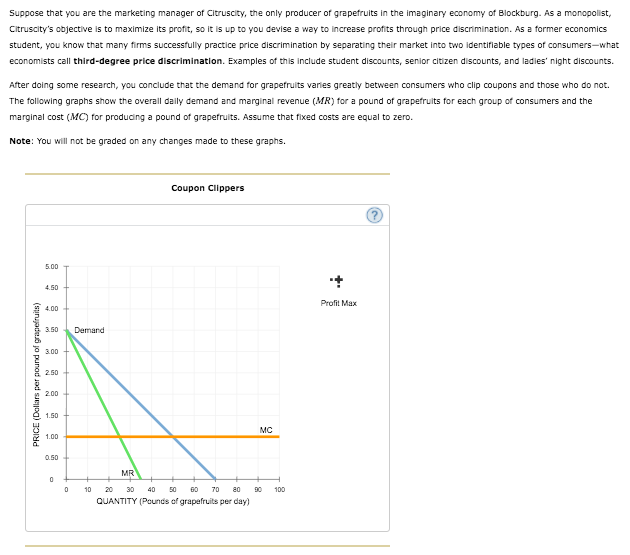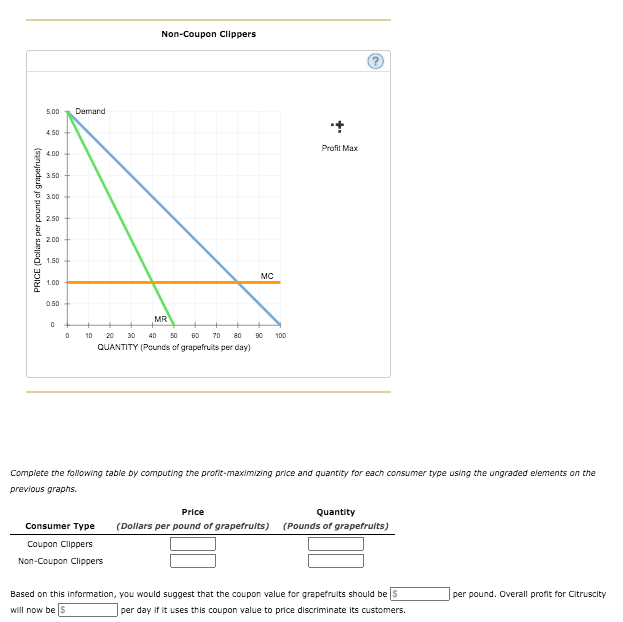Suppose that you are the marketing manager of Citruscity, the only producer of grapefruits in the imaginary economy of Blockburg. As a monopolist, Citruscity's objective is to maximize its profit, so it is up to you devise a way to increase profits through price discrimination. As a former economics student, you know that many firms successfully practice price discrimination by separating their market into two identifiable types of consumers-what economists call third-degree price discrimination. Examples of this include student discounts, senior citizen discounts, and ladies' night discounts. After doing some research, you conclude that the demand for grapefruits varies greatly between consumers who clip coupons and those who do not. The following graphs show the overall dailly demand and marginal revenue (MR) for a pound of grapefruits for each group of consumers and the marginal cost (MC) for producing a pound of grapefruits. Assume that fixed costs are equal to zero. Note: You will not be graded on any changes made to these graphs. Coupon Clippers 5.00 4.50 Profit Max 4.00 3.50 Demand 3.00 2.50 2.00 1.50 MC 1.00 0.50 MR 10 20 30 40 50 60 70 20 90 100 PRICE (Dallars per pound of grapefruits)
Suppose that you are the marketing manager of Citruscity, the only producer of grapefruits in the imaginary economy of Blockburg. As a monopolist, Citruscity's objective is to maximize its profit, so it is up to you devise a way to increase profits through price discrimination. As a former economics student, you know that many firms successfully practice price discrimination by separating their market into two identifiable types of consumers-what economists call third-degree price discrimination. Examples of this include student discounts, senior citizen discounts, and ladies' night discounts. After doing some research, you conclude that the demand for grapefruits varies greatly between consumers who clip coupons and those who do not. The following graphs show the overall dailly demand and marginal revenue (MR) for a pound of grapefruits for each group of consumers and the marginal cost (MC) for producing a pound of grapefruits. Assume that fixed costs are equal to zero. Note: You will not be graded on any changes made to these graphs. Coupon Clippers 5.00 4.50 Profit Max 4.00 3.50 Demand 3.00 2.50 2.00 1.50 MC 1.00 0.50 MR 10 20 30 40 50 60 70 20 90 100 PRICE (Dallars per pound of grapefruits)
Chapter14: Monopoly
Section: Chapter Questions
Problem 14.9P
Related questions
Question

Transcribed Image Text:Suppose that you are the marketing manager of Citruscity, the only producer of grapefruits in the imaginary economy of Blockburg. As a monopolist,
Citruscity's objective is to maximize its profit, so it is up to you devise a way to increase profits through price discrimination. As a former economics
student, you know that many firms successfully practice price discrimination by separating their market into two identifiable types of consumers-what
economists call third-degree price discrimination. Examples of this include student discounts, senior citizen discounts, and ladies' night discounts.
After doing some research, you conclude that the demand for grapefruits varies greatly between consumers who clip coupons and those who do not.
The following graphs show the overall dailly demand and marginal revenue (MR) for a pound of grapefruits for each group of consumers and the
marginal cost (MC) for producing a pound of grapefruits. Assume that fixed costs are equal to zero.
Note: You will not be graded on any changes made to these graphs.
Coupon Clippers
5.00
4.50
Profit Max
4.00
3.50
Demand
3.00
2.50
2.00
1.50
MC
1.00
0.50
MR
10
20
30
40
50
60
70
80
90
100
QUANTITY (Pounds of grapefruits per day)
PRICE (Dollars per pound of grapefruits)

Transcribed Image Text:Non-Coupon Clippers
5.00
Demand
4.50
Profit Max
4.00
3.50
3.00
2.50
2.00
1.50
MC
1.00
0.50
MR
10
20
30
40
50
60
70
80
90
100
QUANTITY (Pounds of grapefruits per day)
Complete the following table by computing the profit-maximizing price and quantity for each consumer type using the ungraded elements on the
previous graphs.
Price
Quantity
Consumer Type
(Dollars per pound of grapefruits)
(Pounds of grapefrults)
Coupon Clippers
Non-Coupon Clippers
Based on this information, you would suggest that the coupon value for grapefruits should be S
per pound. Overall profit for Citruscity
will now be S
per day if it uses this coupon value to price discriminate its customers.
PRICE (Dollars per pound of grapefruits)
Expert Solution
This question has been solved!
Explore an expertly crafted, step-by-step solution for a thorough understanding of key concepts.
This is a popular solution!
Trending now
This is a popular solution!
Step by step
Solved in 2 steps with 1 images

Knowledge Booster
Learn more about
Need a deep-dive on the concept behind this application? Look no further. Learn more about this topic, economics and related others by exploring similar questions and additional content below.Recommended textbooks for you





